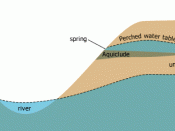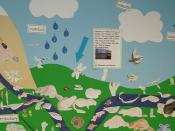GROUNDWATER SALINITY
&
THE WATER CYCLE
The Water Cycle (also known as the hydrologic cycle) is the journey water takes as it circulates from the land to the sky and back again. The energy that evaporates water from the Earth's surface (oceans, lakes, soil and ice) is provided by the sun's heat. The process where plants lose water to the air is called transpiration. Once the water is evaporated into the atmosphere the water condenses and creates clouds by forming tiny droplets. Precipitation is triggered (rain, sleet, or snow) when the clouds meet cool air over land, the water then falls to land or sea.
When precipitation falls over the land surface, it follows various routes. Some of it evaporates, returning to the atmosphere, and some seeps into the ground (as soil moisture or groundwater). Groundwater is found in two layers of the soil, the "zone of aeration," where gaps in the soil are filled with both air and water, and, further down, the "zone of saturation," where the gaps are completely filled with water.
The boundary between the two zones is known as the water table, which rises or falls as the amount of groundwater increases or decreases. The rest of the water runs off into rivers and streams, and almost all of this water eventually flows into the oceans or other bodies of water, where the cycle begins anew. At different phases of the cycle, humans or other life forms intercept some of the water.
Groundwater is significant to all land organisms. The groundwater in the zone of aeration is critical for the growth of plants on which animals and birds feed. If there is insufficient water in this zone (such as during droughts) many plants will wilt and die causing an imbalance in the ecosystem. In Australia,


